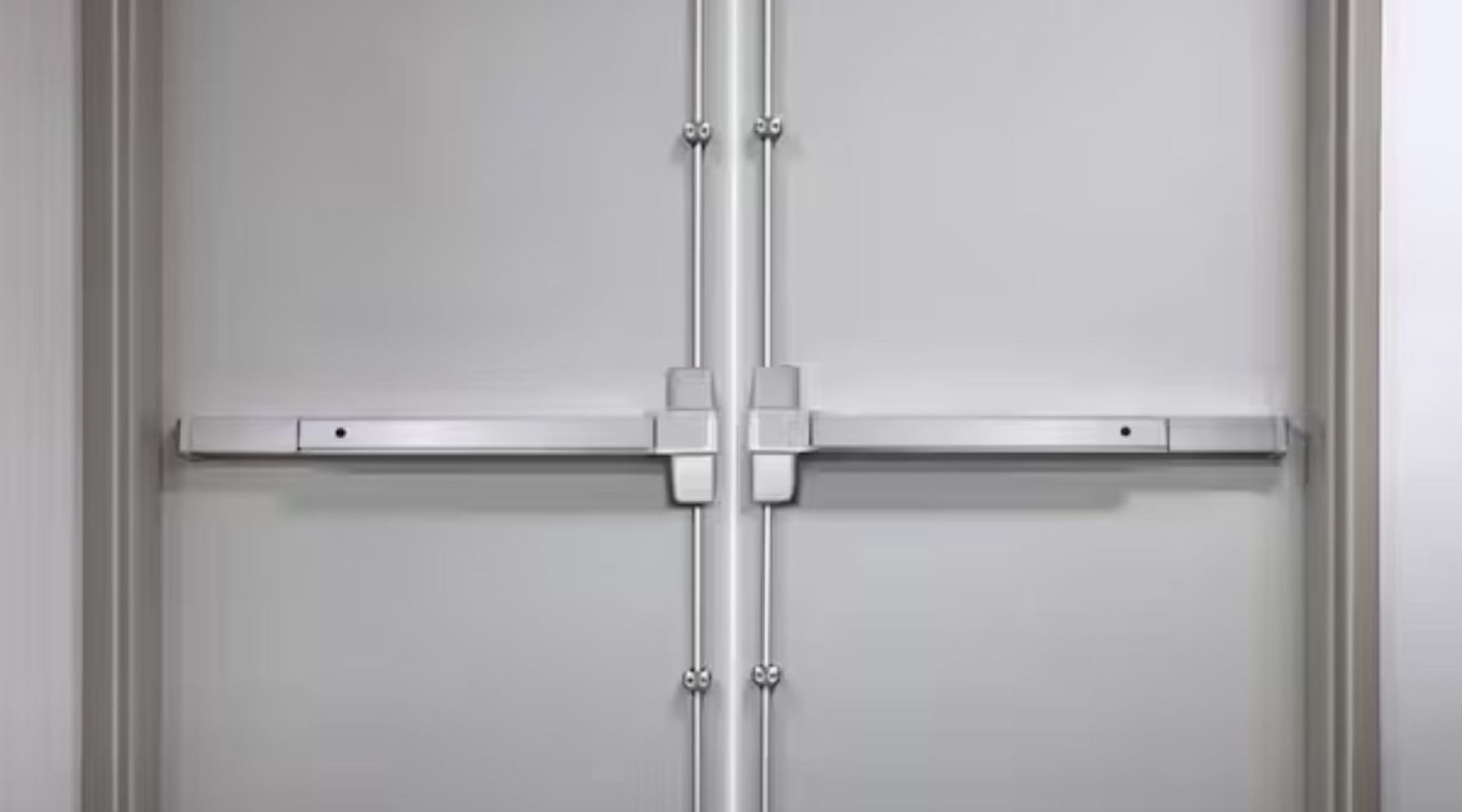
What Are Panic Bolts and When Are They Legally Required?
7 December 2025Panic bolts, which are also known as push pads or crash bars, are commonly used in commercial or public buildings as a safety feature. They are designed to allow a quick exit in emergencies, reducing risk of injury or panic, and often are a legal requirement. In this article we will explain what panic bolts are, the UK laws on their use, and practical guidance for installation and maintenance.
What Is a Panic Bolt?
A panic bolt is a type of door hardware that ensures doors can be opened quickly in emergencies. Typically, there is a horizontal bar/pad that is connected to a latch mechanism. When the bar is pressed, the latch retracts, instantly opening the door.
There are 3 main types of panic bolts: surface panic bolts which are mounted onto the door surface, concealed vertical rods which latch at both the top and bottom of the door for added security, and push pad devices often used on outward-opening doors as they are simple horizontal bars.
The key features of panic bolts include ease of exit, fail-safe operation, and compliance with fire safety standards.
Legal & Regulatory Framework in the UK
In the UK, panic bolts are governed by multiple regulations:
The Regulatory Reform (Fire Safety) Order 2005 – sets fire safety responsibilities for workplaces and public buildings.
Building Regulations Part B – specifies requirements for escape routes in new and existing buildings.
Health & Safety at Work etc. Act 1974 – ensures safe access and egress for employees.
Equality Act 2010 – ensures emergency exits are accessible for all, including disabled people.
Relevant Standards
BS EN 1125: Panic exit devices operated by a horizontal bar.
BS EN 179: Emergency exit devices operated by lever handle or push pad (for lower-risk areas).
BS 8300: Accessibility guidance for disabled people.
Failure to comply with these regulations can result in legal action, fines, or invalidated insurance policies.
When Are Panic Bolts Legally Required?
Generally, panic bolts are required on doors in high-occupancy buildings, to ensure fast and safe evacuation in the event of an emergency. This includes schools, hospitals, theatres, sports arenas and large workplaces. Any door that is part of an escape route, especially outward-opening doors, is likely to require panic hardware.
There are several factors that influence the need for panic bolts. Buildings with a large number of occupants, or long exit routes often need more exit points with panic devices. Local authorities and dire safety certificates can often dictate when and where panic bolts must be installed. For example, a school with multiple classrooms must ensure that outward-opening exit doors on escape routes are equipped with BS EN 1125 compliant panic bolts to meet legal fire safety requirements.
How to Choose the Right Panic Bolt
Choosing the right panic bolt involves balancing compliance, durability and practicality. The panic device has to meet the relevant safety standards such as BS EN 1125, and be made from materials suitable for the building, including stainless steel, brass or aluminium. The door type, be that single or double lead, inward or outward opening, and material, also affects which panic device is appropriate. While safety is paramount, aesthetics are still worth considering, match the hardware finish to the interior design for a balanced look. Above all, certification and correct installation by a professional are essential to ensure compliance and reliable operation.
Installation & Maintenance
Proper installation and maintenance are critical to the effectiveness of panic bolts. The device should be fitted at the correct height, and aligned according to standards with full compatibility for fire doors, intumescent strips and door closers. Regular maintenance and inspection, including checking for wear and applying lubrication helps to prolong the functionality.
Common mistakes, such as fitting devices on inward opening doors without proper consideration, or neglecting routing inspections, can compromise both safety and legal compliance.
FAQs
What’s the difference between a panic bolt and a panic bar (crash-bar)?
They are often used interchangeably, but ‘panic bolt’ usually refers to the entire mechanism, while ‘panic bar’ specifically means the horizontal bar component.
Can I use a panic bolt on inward-opening doors?
Not typically, as standards favour outward opening doors for emergency exits.
Do all exit doors need panic hardware?
Only doors on escape routes in buildings with certain occupancy levels or risk profiles legally need panic hardware.
Summary
Panic bolts are essential for safe and compliant emergency exits. UK regulations such as the Fire Safety Order, Building Regulations Part B, and standards like BS EN 1125 dictate when and where they are required. Choosing the right device, installing it correctly and maintaining it regularly ensures safety, compliance and peace of mind.
References / Further Reading
Regulatory Reform (Fire Safety) Order 2005
Building Regulations Part B – Fire Safety
BS EN 1125: Panic exit devices operated by a horizontal bar.
Guild of Architectural Ironmongers guidance on panic hardware.
Browse our range of certified panic hardware and get expert advice on complaint selection and installation for your building.







